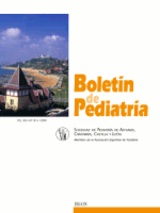Cavernomas cerebrales en la infancia. Aspectos clínicos y radiológicos
R. Palencia
Bol. Pediatr. 2004; 44 (187): 31 - 36
Objetivo: Contribuir al conocimiento de una patología vascular ?cavernomas cerebrales? en la infancia. Pacientes y métodos: Se realiza un estudio clínico y radiológico de cuatro pacientes diagnosticados de cavernomas cerebrales, analizando sus manifestaciones y los hallazgos en la RM. Resultados: No existe predominio en ningún sexo. La localización más frecuente es supratentorial y predominan las lesiones únicas. La semiología clínica es muy variable y la cefalea fue la manifestación clínica más habitual en nuestros pacientes. El tratamiento fue conservador en todos los casos. Conclusiones: Los cavernomas cerebrales constituyen una malformación vascular rara pero no excepcional en la infancia que pueden manifestarse con una clínica muy diversa. La RM es el mejor procedimiento para su diagnóstico. Abstract Objective: To contribute to the understanding of a vascular condition, such as cerebral cavernomas, in childhood. Patients and methods:Aclinical and radiological review of four patients diagnosed with cerebral cavernomas is carried out, examining their manifestations and MRI findings. Results: There is no predominance of either sex. The malformation was most commonly located at the supratentorial level and single lesions predominated. Clinical semiology varied greatly and headache was the most frequent clinical manifestation in our patients. All patients were treated with conservative therapy. Conclusions: Cerebral cavernomas constitute a rare, but not exceptional, vascular malformation in childhood, which can present with a very variable clinical expression. The best diagnostic procedure for this condition is MRI.
\N
\N
Artículo completo (PDF) (102 kb.)
- Neurología
